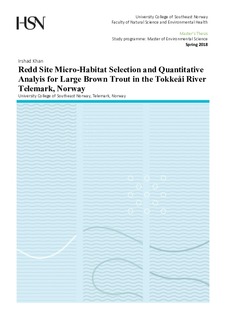| dc.contributor.author | Khan, Irshad | |
| dc.coverage.spatial | Telemark, Norway | nb_NO |
| dc.date.accessioned | 2018-12-14T09:22:01Z | |
| dc.date.available | 2018-12-14T09:22:01Z | |
| dc.date.issued | 2018 | |
| dc.identifier.uri | http://hdl.handle.net/11250/2577691 | |
| dc.description.abstract | The study of redd site microhabitat selection is very important for successful conservation and management of large brown trout. Number of redds is quantified by several reports before but this research has done microstudy on redd site selection. The aim of the study was to study and quantify spawning redd to explore association between physical variables. Direct underwater observation was done after the end of the spawning season in 2016, by using water binoculars and snorkeling to locate and quantify number of large redds in the river. Out of 44 redds found in the study area, medium sized redd (total redd length between 240-400 cm) was dominant (19 out of 44 redds). Number of spawning redd was reduced in 2016 as compared to previous study.
In this study, different microhabitat variables like total redd length, redd depth, water velocity, substrate particle size and morphological and mesohabitat were thoroughly studied. Mean and standard deviation of total redd length (mean ± SD) was 307.34± 135.62 cm and range was 665-74 cm. The correlations between depth and water velocity at 0 cm and 5 cm above the substrate were significant (0.042 < 0.05 at 0 cm and 0.020 < 0.05 at 5 cm above from the bottom at 5% level of significance), but, the correlations were weak, (r=0.157). The correlations between total redd length and average depth at redd was also significant, but again low (r= 0.322).
Redd substrates were dominated by pebble in the size range 31.1- 64 mm and small cobble sized 64-1- 128 mm with 42% and 29% respectively. About 83% of substrate found at the redd was pebble, small cobble and small pebble and within size ranges 16.1-128 mm. Non-turbulent stream flow characterized by run-shallow and run-deep morphology was most prevalent at the redd sites (observed 59 %) among six different types of flow type observed. Relative velocity was equal at Redd’s front, depression length, left and right. Relative velocity and relative depth were at the mean range at maximum number of redds | nb_NO |
| dc.language.iso | eng | nb_NO |
| dc.publisher | University of Southeast Norway | nb_NO |
| dc.subject | brown trout | nb_NO |
| dc.subject | redd site | nb_NO |
| dc.subject | microhabitat | nb_NO |
| dc.title | Redd Site Micro-Habitat Selection and Quantitative Analyis for Large Brown Trout in the Tokkeåi River Telemark, Norway | nb_NO |
| dc.type | Master thesis | nb_NO |
| dc.description.version | publishedVersion | nb_NO |
| dc.rights.holder | Copyright The Author | nb_NO |
| dc.subject.nsi | VDP::Matematikk og Naturvitenskap: 400::Zoologiske og botaniske fag: 480 | nb_NO |
| dc.subject.nsi | VDP::Matematikk og Naturvitenskap: 400::Zoologiske og botaniske fag: 480::Limnologi: 498 | nb_NO |
| dc.subject.nsi | VDP::Landbruks- og Fiskerifag: 900::Fiskerifag: 920::Ressursbiologi: 921 | nb_NO |
| dc.subject.nsi | VDP::Matematikk og Naturvitenskap: 400::Zoologiske og botaniske fag: 480::Økologi: 488 | nb_NO |
